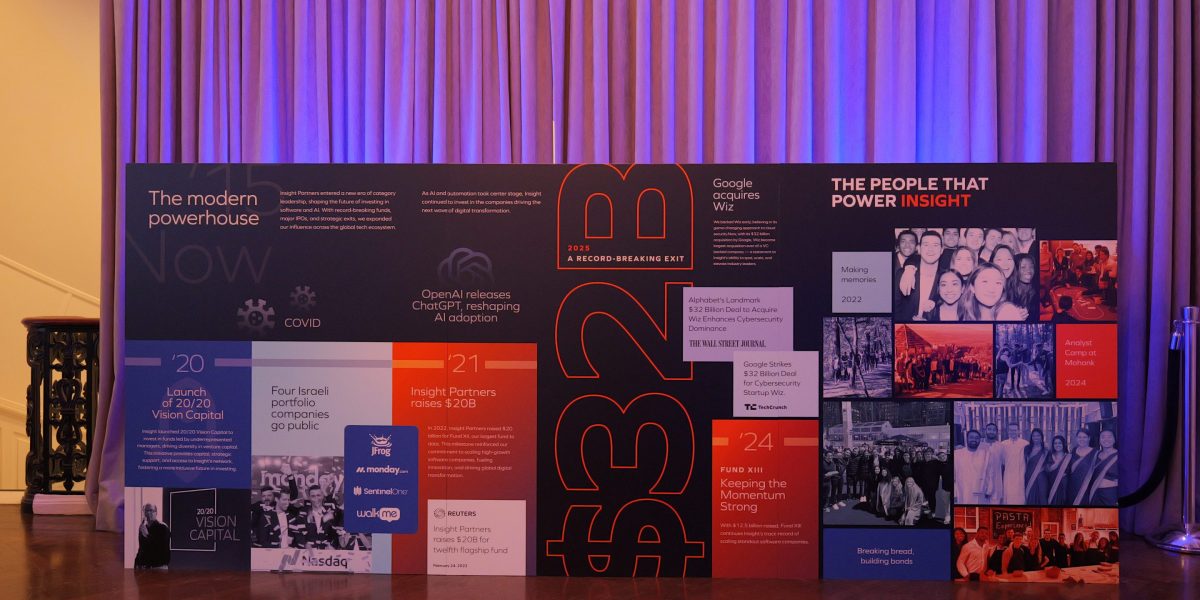In early April, Insight Partners’ cofounder and managing director Jeff Horing took the stage at his firm’s sourcing summit, a one-day annual event where Insight gathers its early-career analysts to train them on the firm’s secret formula for success.
Horing is one of the more elusive figures in venture capital, keeping a low profile even as Insight has imprinted a $90 billion, multi-decade footprint on software investing. He was at ease, though, as he surveyed the 75-odd-person crowd of future investors, many of them straight out of college. In his 25-minute, ad-libbed address, Horing compared their job to baseball. “Your edge [in investing] only comes from pitches that you look at,” he said. “You can be the best baseball hitter in the world, but if you don’t see the pitches, you’re not going to make the hits.”
Founded in 1995, Insight is one of the most influential venture and private equity firms in tech. Helped by its deep roster of investors and outsize pool of capital, the New York-based firm has backed companies from Twitter to Wiz, growing its assets under management by 11x over the past decade and returning billions of dollars to investors in 2024 alone.
Where Insight really stands out, though, is its model for finding investments, which is unique in the field of venture capital. Most firms have a top-down approach built around their partners, who are typically veteran operators or investors and source their own deals. Insight, in contrast, relies on its analyst program, hired straight out of college and trained in the art of cold calling and relationship building. Around 60% of the firm’s venture deals come from the sourcing team.
Most of the analysts come into the firm as summer analysts when they are rising seniors in college, and then return after graduation. Last year, Insight received around 5,000 applications for the internship, hiring just 14 candidates, making the program an order of magnitude more competitive than Harvard.
Looking out at the crowd, Horing described the assembled analysts as the “lifeblood of Insight.”
“Sourcing is everything,” he added.
Outbound pioneers
Horing started Insight with Jerry Murdock, now retired, several years before the early 2000s dot-com boom and bust, back when investing in B2B software companies was still a relative novelty. In his speech during Insight’s summit, Horing said the inspiration for Insight’s bottom-up approach came from two private equity firms, Summit Partners and TA Associates. The idea was that, rather than relying on inbound opportunities, Insight could develop a framework for measuring the future likelihood of success in startups—say, web traffic or revenue—and then find potential deals themselves.
But in the early days of the firm, before Insight brought on analysts, Horing and Murdock would source all the deals themselves, often leafing through pages of software trade publications to look at which startups were hiring—and therefore growing.
Until that point, it was almost unheard of for venture capital firms to hire out of college—that was more the domain of banks and consulting firms. But why wait to hire someone in their mid-20s after they’ve done a few years at McKinsey and retrain them to be an investor? Why not just hire them out of undergrad?
Insight began to experiment with the idea around 2001, launching its first summer analyst program two years later. Ryan Hinkle, now a managing director, joined that inaugural internship class. “I jumped in with both feet at a moment in time where no analyst had been promoted in the history of Insight,” Hinkle told Fortune in an interview. “There was no path—it was this conviction and belief that what we’re doing is special.”
Today, Hinkle helps lead the analyst program. He worked with Insight’s executive vice president of marketing Nikki Parker to build out the sourcing summit—a kind of sales kickoff for early-career employees, now in its third year. He said the analyst-first approach is rooted in Insight’s rethinking of the traditional portfolio theory in venture, where most firms focus on a specific stage of investment, such as seed or growth, but across different sectors. Insight, instead, invests at different stages, but concentrated on software, and generally B2B software.
“Sourcing became necessary because no one had heard that story before,” Hinkle told Fortune. “Initially, the sourcing program was the evangelical wing of the Insight experience, so that every founder that was relevant to our investment thesis knew we existed.”
The program is now institutionalized. At the summit, senior Insight employees taught the gathered analysts and associates how to do cold outreach and meticulously track their communications and conversations—they estimate it takes around 9 touches to break through to a potential lead. Last year, Insight analysts made nearly 50,000 calls, sent 300,000 emails, and reached out to 65,000 companies.
But it wasn’t always that way. Nnamdi Okike was a member of one of Insight’s first analyst classes in 2002. He spent a decade at the firm before starting his own venture firm, 645 Ventures, with Insight’s backing. He told Fortune that he remembers being seated at a desk with a computer and a phone when he started and being instructed to start making calls.
“My first couple of years, I was a glorified telemarketer,” he joked. “And really not very glorified.”
Okike said that Insight pioneered the practice of outbound sourcing by developing metrics for what it was looking for in a startup. Based on one—web traffic—he remembers sourcing Facebook back when it was called TheFacebook, even meeting with the original cofounder Eduardo Saverin. Unfortunately for Insight, the firm ultimately passed on the future Meta colossus because it was too early stage.
Landing a job
There are more spots available in the analyst program than when Hinkle or Okike started, but it’s still highly competitive, with only around 14 out of 5,000 applicants hired every year. Hinkle said that anyone hired as a summer analyst, or intern, has a seat available after they graduate, though Insight will typically supplement with a few full-time hires.
There is no set structure, though after they start work full-time in September, analysts are eligible for a promotion to associate two Memorial Days later. Hinkle says that out of around 500 analysts in the firm’s history, around half have become associates. They then get to decide what type of deals they want to focus on, such as earlier-stage investing or buyouts. “The third and fourth years tend to be the juiciest years of a person’s sourcing history,” Hinkle said.
Harley Miller started as an analyst in 2010 before climbing the ranks to associate, senior associate, vice president, and principal. He left in 2019 to start his own venture firm, the consumer-focused Left Lane Capital, which Insight backed. “You were live, you were in it,” Miller said, recalling his early days at the firm. “You have to be able to deal with a little bit of ambiguity and amorphousness in that day-to-day and derive energy from that.”
Hinkle said that when looking at applicants, Insight mostly looks at qualitative indicators: Do candidates have an enthusiasm for tech without necessarily being a coder, a sales mindset, and an entrepreneurial spirit? “You have to be a self-starter and be motivated that I’ve made 25 outreach attempts—I can go home, but I can also spend six minutes and do one more,” he told Fortune.
Once hired, Hinkle said that Insight emphasizes apprentice-style live coaching, where analysts and associates are brought along to deal negotiations and board discussions to observe before being encouraged to speak up. “You just start to build your database of impressionability and a track record of being effective with CEOs and management teams,” he said.
30 years into Insight’s history, with software-focused venture capital now one of the most competitive asset classes, the firm is still exceptional for building its sourcing around 22-year-olds. “It works for us because for over two decades, that has been true,” said Hinkle. “I was recruited with that tagline, and I still recruit with that tagline.”
This story was originally featured on Fortune.com
Source link


 Politics8 years ago
Politics8 years ago
 Entertainment8 years ago
Entertainment8 years ago
 Entertainment8 years ago
Entertainment8 years ago
 Entertainment8 years ago
Entertainment8 years ago
 Tech8 years ago
Tech8 years ago
 Tech8 years ago
Tech8 years ago
 Tech8 years ago
Tech8 years ago
 Politics8 years ago
Politics8 years ago






